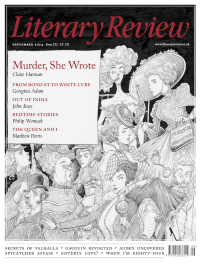Frances Wilson
Best of Frenemies
The Virago Book of Friendship
By Rachel Cooke (ed)
Virago 400pp £18.99
The Virago Book of Friendship is an anthology of writings centred on friendships between women. The lack of gender specificity in the title takes us to the nub of the problem: friendships between women exist in life but not in literature, at least not in literature from before 1940, when Vera Brittain paid tribute to Winifred Holtby in Testament of Friendship. There are sisters galore in 18th- and 19th-century novels, but not the kind of ‘bosom friend’ that Anne Shirley longs for in Anne of Green Gables, or the support groups described in Sex and the City and Bridget Jones’s Diary.
What about Anna Howe and Clarissa, you cry, or Helen Burns and Jane Eyre, or Elizabeth Bennet and Charlotte Lucas in Pride and Prejudice? The friendship in Clarissa (1748) between Samuel Richardson’s tragic heroine and Anna, her great confidante, is derided as much as it is celebrated. While Colonel Morden believes their relationship an exception to the rule that friendship is ‘too fervent a flame for female minds to manage’, Robert Lovelace, who is pursuing Clarissa, considers their tittle-tattle ‘nothing but chaff and stubble’. Where women are concerned, Lovelace argues, friendship is ‘a mere word … a cork-bottomed shuttlecock’. ‘When a man comes in between the pretended inseparables,’ friendship ‘is given up’. The truth of this theory is never tested because, after Lovelace rapes her, Clarissa dies. Helen Burns also dies, while Charlotte Lucas marries Mr Collins. If it’s hard to imagine Elizabeth’s friendship with Charlotte surviving her marriage, it’s not because the relationship is a cork--bottomed shuttlecock but because she loathes Charlotte’s husband.
The last anthology of this kind, Rachel Cooke writes in her chatty introduction, was The Oxford Book of Friendship (1991), edited by D J Enright and David Rawlinson, in which the briefest of chapters is reserved for friendships between women (and with no mention of Katherine Mansfield). While examples of

Sign Up to our newsletter
Receive free articles, highlights from the archive, news, details of prizes, and much more.@Lit_Review
Follow Literary Review on Twitter
Twitter Feed
It wasn’t until 1825 that Pepys’s diary became available for the first time. How it was eventually decrypted and published is a story of subterfuge and duplicity.
Kate Loveman tells the tale.
Kate Loveman - Publishing Pepys
Kate Loveman: Publishing Pepys
literaryreview.co.uk
Arthur Christopher Benson was a pillar of the Edwardian establishment. He was supremely well connected. As his newly published diaries reveal, he was also riotously indiscreet.
Piers Brendon compares Benson’s journals to others from the 20th century.
Piers Brendon - Land of Dopes & Tories
Piers Brendon: Land of Dopes & Tories - The Benson Diaries: Selections from the Diary of Arthur Christopher Benson by Eamon Duffy & Ronald Hyam (edd)
literaryreview.co.uk
Of the siblings Gwen and Augustus John, it is Augustus who has commanded most attention from collectors and connoisseurs.
Was he really the finer artist, asks Tanya Harrod, or is it time Gwen emerged from her brother’s shadow?
Tanya Harrod - Cut from the Same Canvas
Tanya Harrod: Cut from the Same Canvas - Artists, Siblings, Visionaries: The Lives and Loves of Gwen and Augustus John by Judith Mackrell
literaryreview.co.uk